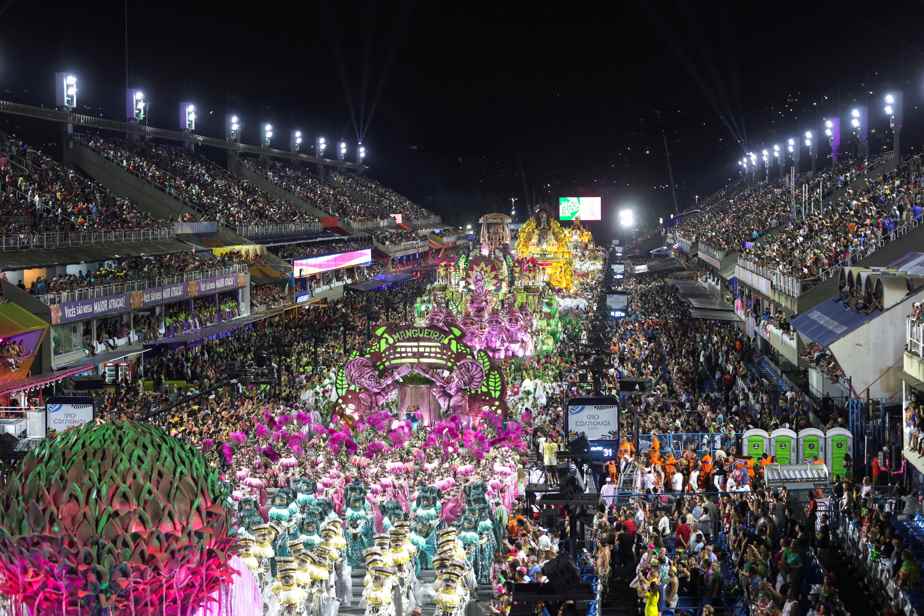(Rio de Janeiro) Rio de Janeiro celebrated on the night of Monday to Tuesday its full reunion with the joy, the excess and the splendor of its famous carnival, after the parenthesis of the COVID-19.
A jam-packed sambadrome saw six great samba schools parade for the second and last night in a very creative enchantment of monumental floats, extravagant costumes and multicolored feathers, to the deafening sound of percussion.
A total of 12 samba schools followed one another in two frenzied nights until dawn on the avenue du sambodrome, in front of 70,000 spectators each evening and tens of millions of television viewers.
At stake is the hotly contested title of champion of the most grandiose carnival on the planet, the meeting of the year for Brazilians, an outlet, an enchanted parenthesis of popular jubilation.
Each school had an hour to create the strongest impression on the jury, with monumental floats some 20 meters high and some 3,000 dancers roaming the 700-meter avenue lined with bleachers.
First to set off, Paraiso do Tuiuti paid homage to the buffaloes used on an island in northeastern Brazil, while making a detour to India and Hindu rites.
It celebrated the beauty of nature, with dancers in orange, green or neon yellow costumes, while honoring indigenous culture and slaves from Africa.
“It’s a very, very special carnival, the first where I’ve been marching since COVID-19,” Stefani Claudia da Concepçao, a 34-year-old dancer with a ruddy mouth, wearing feathers, told AFP.
In 2021, Brazilians had been deprived of the carnival which is part of the DNA of the people: the party had been canceled due to the coronavirus pandemic which resulted in 700,000 deaths.
And last year, the carnival, which usually takes place in the heat of the southern summer, was postponed to April. The very popular street processions, these “blocos” which can bring together hundreds of thousands of revelers, had not taken place.
“The culture of a whole people”
This 2023 carnival was also the first since the return to power of left-wing President Luiz Inacio Lula da Silva, who in October defeated outgoing far-right head of state Jair Bolsonaro.
“Carnival has political significance this year,” explains Carla Andrea Barbosa, a fifty-year-old costume designer who has been there for 30 years.
“I marched with almost every school,” she laughs, of the pagan holiday that samba schools, mostly based in favelas, have been working on for months.
“Carnival represents the culture of an entire people and before, the freedom of expression of our culture was suppressed,” she says. The Bolsonaro government had abolished the Ministry of Culture, cut credits and censored creations it disliked.
Lula has promised to restore its place to culture in Brazil and, sign of the times, the Minister of Culture, Margareth Menezes, had marched on top of a float from the school of Mangueira in the night from Sunday to Monday.
The most successful Portela school celebrated its 100e anniversary by illustrating its long history in infinite shades of blue and white, its legendary colors.
That of Vila Isabel paraded Vikings, nymphs, satyrs and medieval knights, when Imperatriz celebrated the arid land of Sertao (North-East) and presented a gigantic allegorical chariot of death.
For Beija-Flor, the message was more political: the defense of the excluded – -LGBT, indigenous people – and the fight for equality between men and women.
A windfall for Rio
The sambadrome danced wildly all night long. At the head of the processions swayed the scantily clad “battery queens”, with their bodies sculpted by sports trainers, nutritionists and often plastic surgeons.
The “greatest spectacle on Earth” is a godsend for Rio, a postcard seaside metropolis which welcomes five million tourists for a month and will earn 800 million euros this year, with an occupancy rate of its hotels of 95 %.
Carnival is also celebrated in other Brazilian cities such as Bahia, Olinda, Belo Horizonte. But in Sao Paulo, the celebration was overshadowed this year by torrential rains in the north of the state which left 40 dead and dozens missing.
